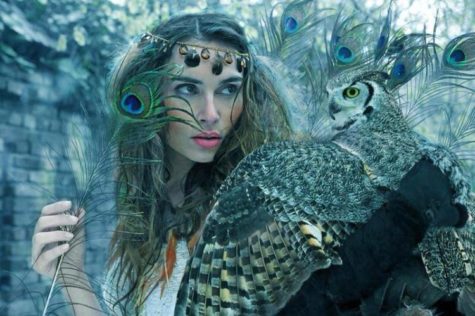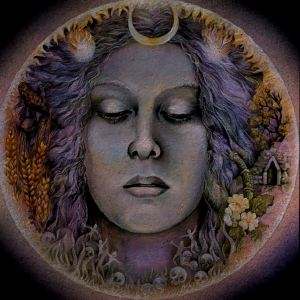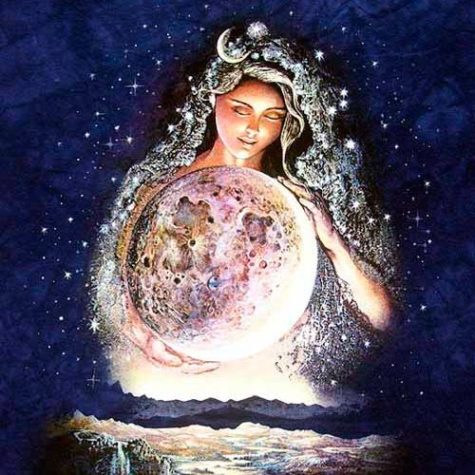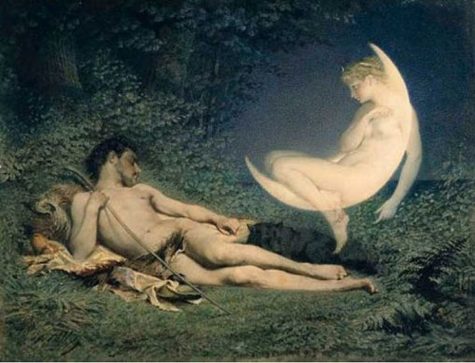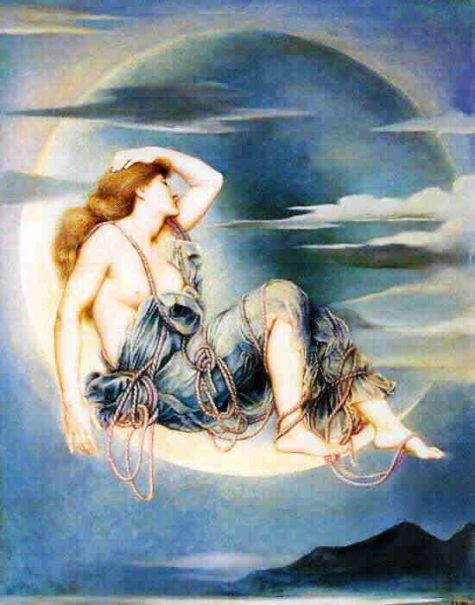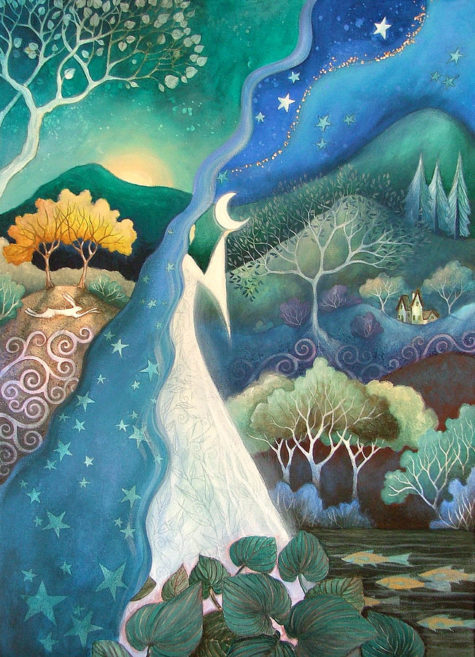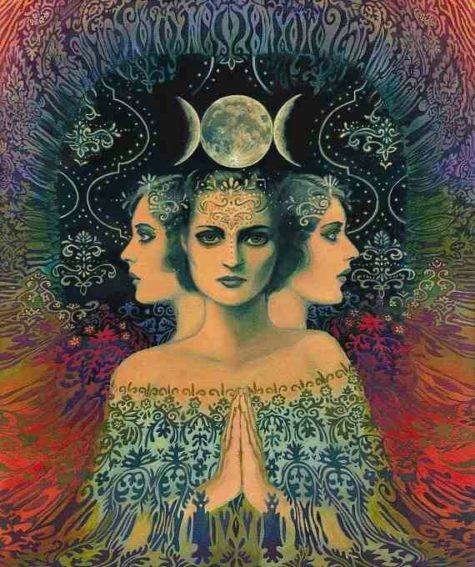Moon
Great Goddess, Moon Goddess, Queen of the Witches
In the late twentieth century, Aradia emerged as an important Wiccan goddess. She is a major spiritual inspiration for modern Wiccans and practitioners of witchcraft. Rites and descriptions are found within her book and testament. Here’s a link to her story and teachings: The Story of Aradia.
- Number: 13
- Offerings: Strega liquore, walnuts, rue, tools of witchcraft and divination
Aradia has become an important figure in Wicca as well as some other forms of Neo-Paganism. Some Wiccan traditions use the name “Aradia” as one of the names of the Great Goddess, Moon Goddess or “Queen of the Witches”. Portions of Leland’s text influenced the Gardnerian Book of Shadows, especially the Charge of the Goddess.
Between 1950 and 1960, “Aradia” was probably the secret name of the Goddess in Gardnerian Craft. The Goddess Aradia is a central figure in Stregheria, an “ethnic Italian” form of Wicca introduced by Raven Grimassi in the 1980s.
The Goddess form of Aradia today is that of a nature Goddess, crowned with the crescent Moon of Her mother/other self-Diana. She is young and beautiful, but wise. Her consorts are Cernunnos, Herne or Pan.
Aradia ~ The Origin Stories
In the beginning was Diana, primordial Spirit of Darkness. She divided the world into complementary opposites: yin and yang, male and female, light and darkness. The light half evolved into her brother, Lucifer. Diana desired him, wishing to unite and merge, but Lucifer wanted light to remain completely distinct from darkness. Diana pursued him but he resisted.
Lucifer slept with his favorite cat. Diana switched places with her and so she seduced her brother, in the guise of a black cat. From this union, the world’s first witch was conceived: Aradia, Messiah of Witches.
Diana descended to Earth disguised as a mortal where Her knowledge and passion for witchcraft made Her so powerful that She became the Queen of the Witches. She became so well known that She was forced to shed Her human disguise and return to heaven. The Queen of the Witches had a duty to continue to teach witchcraft on earth so She delegated this task to Her daughter Aradia.
Diana instructed Aradia to:
“Go to earth below
To be a teacher unto women and men
Who fain would study witchcraft.
Yet like Cain’s daughter thou shalt never be,
Nor like the race who have become at last
Wicked and infamous from suffering,
As are the Jews and wandering Zingari,
Who are all thieves and knaves; like unto them
Ye shall not be….
And thou shalt be the first of witches known;
And thou shalt be the first of all i’ the world;
And thou shalt teach the art of poisoning,
Of poisoning those who are great lords of all;
Yea, thou shalt make them die in their palaces;
And thou shalt bind the oppressor’s soul (with power);
And when ye find a peasant who is rich,
Then ye shall teach the witch, your pupil, how
To ruin all his crops with tempests dire,
With lightning and with thunder (terrible),
And the hail and wind…. ”
Aradia would be the first of the known witches in the entire world. Diana instructed Her in the arts of poisoning, binding and paralyzing so that She would be able to defend and protect Her followers from the tyranny and oppression of the Church.
Aradia was a Goddess who didn’t have any qualms at all about exacting retribution upon those who harmed her followers. When Aradia descended to earth, she became the first of all witches, and promised her students that:
“Ye shall all be freed from slavery,
And so ye shall be free in everything”.
The legend of Aradia may have originated in a dim memory of an actual woman who was a great teacher of magick and witchcraft and who was a defender of the poor. Like King Arthur or Jesus of Nasareth the myth figure can also become the deity. The Goddess form evolves and acquires its own independent validity and power.
That’s the first coming of Aradia the Messiah according to the mysterious grimoire, Aradia or The Gospel of the Witches. Aradia returned for a second coming too.
This Aradia was born in Volterra, Italy, on August 13, 1313, and stimulated a revival of Italian witchcraft and pre-Christian traditions long driven into hiding by the Church. She learned the Old Ways from her family and taught them to others. She was caught by the Inquisition and burned but not before leaving the manuscript that is allegedly the framework for the testament Aradia or the Gospel of Witches, published in 1899 by folklorist C G Leland.
No documentation regarding either Aradia exists prior to publication, but in 1508, Italian Inquisitor Bernardo Rategno noted that a rapid expansion of witchcraft had occurred one hundred fifty years earlier, corresponding in time with Aradia’s second coming.
The story of Diana as Creator of the World, Mother of Witchcraft, does not correspond with anything from classical mythology, although that in itself proves nothing. Many myths and deities are known from but one single source. This could be another instance of a lone survival of an ancient myth, or it could be an attempt to defame witches.
The name Lucifer (light bringer) predates Christianity and was a title given to various Roman deities, female and male. It was originally intended as benevolent, but during the medieval period when Aradia was allegedly written, Lucifer was exclusively identified with Satan, the proud handsome fallen angel. Inquisitors branded Diana as the bride of Lucifer in order to damn and defame her devotees.
The name Aradia resembles Herodias, among medieval Italy’s favorite witch-goddesses. Leland, for his part, thought Aradia was a distortion of Lilith, the real first woman, not the New Testament’s Herodias. Italian Jews who brought Lilith to Italy do identify her with black cats.
Current historians and folklorists still can’t prove or deny the story created by the book published more than a hundred years ago. Nonetheless, Sabina Magliocco, a specialist in Italian folklore, believes that Aradia’s legend is a compilation of many characters known from ancient times to the 19th century.
She suggests that Aradia must have been a supernatural creature related to Italian folklore. Magliocco identified Aradia with the legendary witch figure – who is probably a supernatural legend known in the Sardinian tradition as ”sa Rejusta”.
Another theory comes from Raven Grimassi, who created Stregheria – a neo-pagan tradition. He says that a woman known as Aradia di Toscano was a real person who lived in the 14th century and was a witch, or a powerful leader of a group of witches, who worshiped the goddess Diana. Grimassi supposed that the woman described by Leland was none other than a medieval witch who believed she was an ancient goddess’ daughter.
One more hypothesis comes from Mircea Eliade, a Roman historian of religion who lived between 1907 and 1986. Eliade suggested that the name Aradia comes from Arada and Irodiada – a folkloric name for the famous Queen of the Fairies. In Romanian culture, she was related to Diana and was a patron for a group of dancers who existed until the end of the 19th century (although it’s possible that they secretly continue their work even now.)
Sources:
- Encyclopedia of Spirits
- Sacred Wicca
- Ancient Origins
- Also known as: Mene (as in month or menstruation), and Latin Luna
- Origin: Greece
- Stones: Moonstones and Selenite (literally “moon rock”)
- Favored people: She is the matron of magicians, sorcerers, witches, and moon-gazers.
Selene is an ancient goddess of the moon. Comparatively little information regarding Selene’s veneration and rituals survives although she is described as “great in magic” and was apparently invoked in magic spells. Her parents are Titans, Hyperion and Theia. Helios, the sun, is her brother. Many of her functions were later transferred to Artemis as Helios’ were to Apollo.
Selene bathes in the ocean before riding up to the sky in her chariot every night, variously driven by a pair of white horses, bulls, or mules. She pulls the full moon across the sky. Alternatively she rides a horse sidesaddle. Sometimes Selene has to hide from a dragon, indicated by a lunar eclipse or absent moon. Or perhaps Selene is just making time with that dragon. Selene is an amorous goddess with many lovers including Pan and Zeus, with whom she had numerous children.
Her most famous love affair is with the young shepherd Endymion, the male sleeping beauty. Selene placed him under an eternal sleep spell so that his entire existence consisted of sleeping and making love to her. Selene spends her days in the Anatolian cave in which Endymion sleeps.
Selene’s name is etymologically related to a word meaning “light.” In her guise as the full moon, Selene sheds light on problems and mysteries.
- Manifestation:
Selene is the goddess of the moon, but she also is the moon. Selene may manifest as a woman or a cow, but you can also gaze at the moon and see her. As a woman, she is described as being very beautiful. She has wings and wears a diadem.
A scholarly article about the Goddess Selene:
Also called Mene, or Latin Luna, Selene was the goddess of the moon, or the moon personified into a divine being. She is called a daughter of Hyperion and Theia, and accordingly a sister of Helios and Eos; but others speak of her as a daughter of Hyperion by Euryphaessa, or of Pallas, or of Zeus and Latona, or lastly of Helios. She is also called Phoebe, as the sister of Phoebus, the god of the sun.
By Endymion, whom she loved, and whom she sent to sleep in order to kiss him, she became the mother of fifty daughters; by Zeus she became the mother of Pandeia, Ersa, and Nemea . Pan also is said to have had connection with her in the shape of a white ram.
Selene is described as a very beautiful goddess, with long wings and a golden diadem, and Aeschylus calls her the eye of night. She rode, like her brother Helios, across the heavens in a chariot drawn by two white horses, cows, or mules. She was represented on the pedestal of the throne of Zeus at Olympia, riding on a horse or a mule; and at Elis there was a statue of her with two horns.
In later times Selene was identified with Artemis, and the worship of the two became amalgamated. In works of art, however, the two divinities are usually distinguished; the face of Selene being more full and round, her figure less tall, and always clothed in a long robe; her veil forms an arch above her head, and above it there is the crescent. At Rome Luna had a temple on the Aventine.
Ritual to Selene
- Color: White and silver
- Element: Water
Altar: Lay with a white cloth, on which is sewn moons of silver in cycle from new to dark. Set out two white candles rubbed with jasmine oil, a silver tray with round white cakes, a glass pitcher of goat’s milk, a glass chalice of white wine, a glass of clear anise liqueur, a round mirror, and a silver bell.
Offerings: White foods. Milk, poured in libation. A promise to aid those suffering from mental illness or emotional confusion.
Daily Meal: Nothing but milk or rice milk to drink. Rice. Custard. Cream soups and sauces.
Invocation to Selene
Lady of the Full Moon
White Lady whose rays shine on us
Lighting our path through the darkness
Round as a full belly
Pregnant with possibilities,
White as mother’s milk
And snow on high mountaintops,
Moon mother who sings to us
Lullabies of imagination,
Cascade through our dreams,
Sail us through the ebb and flow
Of our heart’s tides,
And light our spirits
With your serene love.
Chant: Luna Lucina Lumen Lumen
The cakes are passed around, saying, “Eat of the Mother’s sweetness.” Then the pitcher of milk is passed around, saying, “Drink of the Mother’s love.” Then the chalice of wine is passed around, saying, “Drink of the Mother’s dreams.” Then the glass of liqueur is passed around, saying, “Drink of the Mother’s song.” Then the remainder are poured out as libations and the silver bell is rung six times.
Sources:
The Three Mothers, or Triple Goddess, were known around the world. The Triple Goddess represented the three stages of human life: youth and puberty, parenthood and maturity, old age and wisdom; or body, mind, and spirit. This triad symbolizes the three phases of the Moon: Crescent, Full, and Dark. The goddesses were most often known by the titles of Maid, Mother, and Crone. The ancient Mystery schools, which were originally centers of Goddess knowledge, had three main steps or degrees.
The number three was a sacred number from the time of the ancient Babylonians on. Pythagoras wrote that the Universal Order had to manifest itself in threes. The ancient Chinese thought that three engendered all things. Even today, in numerology the number three stands for activity, creativity, talent, and knowledge.
The Celtic countries, in particular, honored this triad as the bringer of prosperity and a good harvest. The Celts considered the Horned God of the Forests to be Her consort and help-mate. During the month of May, especially at the ceremony of Beltane, wearing of the color green and freely expressing themselves sexually was widely practiced by the Celts. This practice became a real headache for the Christians when they took over. They tried to curb this custom by declaring that the color green was unlucky ant that sex was sinful and dirty.
We can look at the Three Mothers as more than sexual activity. They are symbols of the cycles of growth upon the Earth, the phases we physically go through in our present life, cycles of events within our lives.
Sometimes we are uncertain as to where we actually are in a cycle of events. This can be frustrating and depressing. We may have to endure until the completion of the cycle, but it’s comforting to have some idea how much longer we must grin and bear it. The Three Mothers Tarot Divination can give you some insight.
From: Moon Magick
